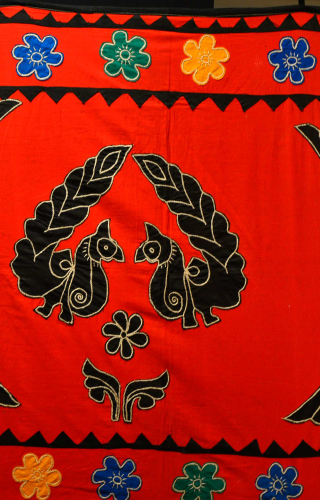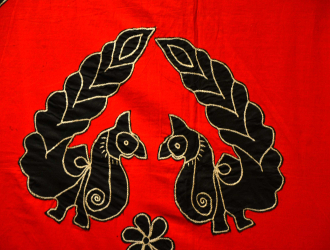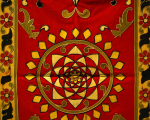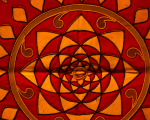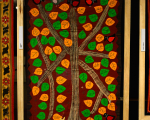This image gallery presents examples of Appliquéd textiles.
Appliqué is a decorative technique where SURFACE fabrics of varied shapes and colours are stitched, blindly or decoratively, on to a background or BASE fabric. Similar to patchwork, appliqué can take any form - figurative, ornamental, geometric - and is often made with old or leftover scraps of material.
Traditional appliqué is found in many parts of India and is of several types. The most common is on-lay appliqué where the surface fabric is cut in the shapes of the desired motifs and stitched to the base fabric. In negative appliqué, the surface cloth defines the outlines of the motifs, which are given 'body' by the base fabric. Inlay appliqué is where both surface and background fabrics are cut and stitched together like a jigsaw. In raised appliqué, the surface fabric is padded to create a three-dimensional effect. A variant of this is folded appliqué where designs are made in the surface fabric by folding the cutting, sometimes into strips, which are stitched on the base fabric. These designs too can give a three-dimensional effect, especially when the stitching of the surface fabric is pulled. In shadow appliqué, shapes are attached to the reverse of a fine, semi-transparent fabric like muslin, and are seen in the play of light—a technique used in chikan embroidery.
A further distinction may be made between those traditions where appliqué is used for decorative purposes and those where cloths are added to repair a damaged fabric, as in some Gujarat patchwork traditions. In certain traditions like Banjara, appliqué is combined with embroidery.
Appliqué traditions were often associated with ritual purposes. Appliquéd canopies, umbrellas, caparisons, screens etc, were used in religious festivals. Now the craft is used to make decorative household objects. Important appliqué traditions are found in Gujarat, Rajasthan, Uttar Pradesh, Bihar, Odisha, Andhra Pradesh and Tamil Nadu. Each has a distinct format, colour scheme and range of motifs, with varying degrees of stylisation and sophistication: Rabari, Kathi, Mochi and Muslim appliqué from Gujarat; Mahajan from Saurashtra, Gujarat; Satwara, as well as Marwari and Meghwal from Rajasthan; Tharu from Uttar Pradesh; Khatwa from Bihar; Pipli from Odisha, and Tanjore from Tamil Nadu.
